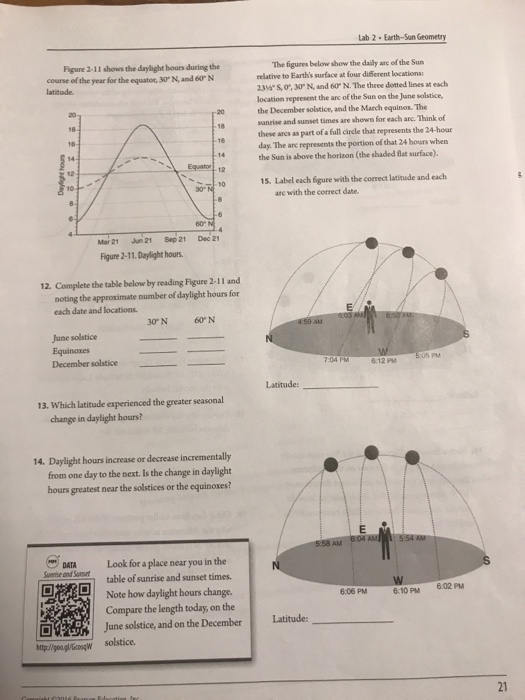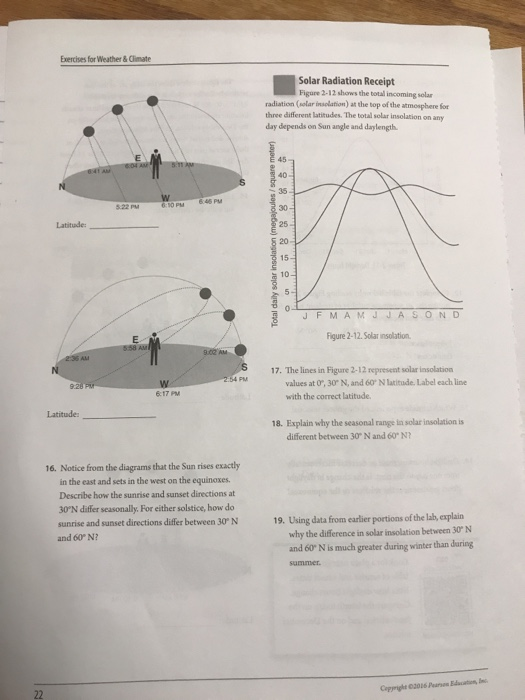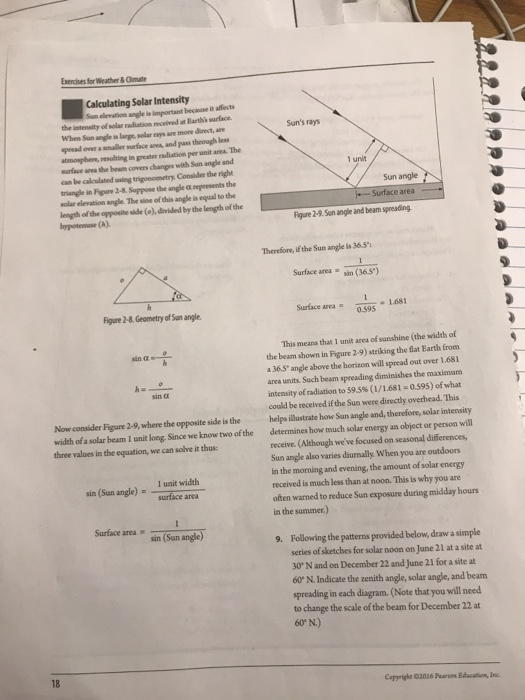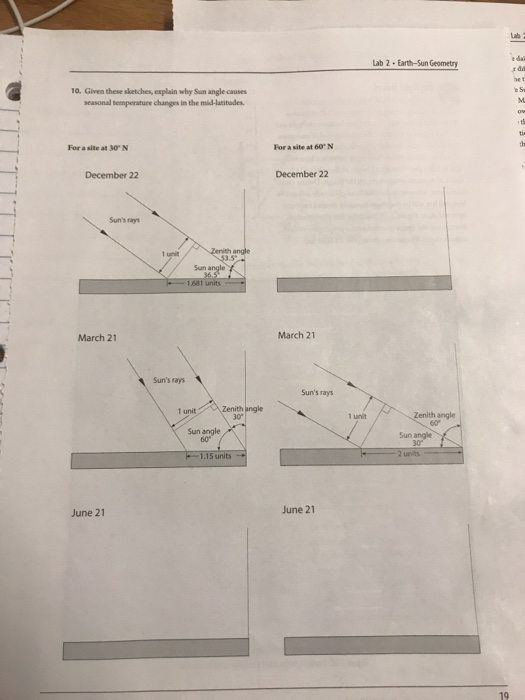Answered step by step
Verified Expert Solution
Question
1 Approved Answer
Figure 2-11 shows the daylight hours during the course of the year for the equator, 30 N, and 60 N latitude. Daylight hours 822222




Figure 2-11 shows the daylight hours during the course of the year for the equator, 30 N, and 60 N latitude. Daylight hours 822222 20- 18- 16- 14- 12 8 June solstice Equinoxes December solstice Mar 21 Jun 21 Sep 21 Figure 2-11. Daylight hours. DATA Sunrise and Sunset http://goo.gl/GcosqW 12. Complete the table below by reading Figure 2-11 and noting the approximate number of daylight hours for each date and locations. 02016 B -14 Equator 12 10 30 N -18 -16 30 N Edu -8 13. Which latitude experienced the greater seasonal change in daylight hours? -6 14. Daylight hours increase or decrease incrementally from one day to the next. Is the change in daylight hours greatest near the solstices or the equinoxes? 60 N Dec 21 60 N Look for a place near you in the table of sunrise and sunset times. Note how daylight hours change. Compare the length today, on the June solstice, and on the December solstice. Lab 2. Earth-Sun Geometry The figures below show the daily arc of the Sun relative to Earth's surface at four different locations: 234 S, 0, 30 N, and 60 N. The three dotted lines at each location represent the arc of the Sun on the June solstice, the December solstice, and the March equinox. The sunrise and sunset times are shown for each arc. Think of these arcs as part of a full circle that represents the 24-hour day. The arc represents the portion of that 24 hours when the Sun is above the horizon (the shaded flat surface). 15. Label each figure with the correct latitude and each are with the correct date. 4:50 AM Latitude: N Latitude: 6:03 AM 7:04 PM 6:12 PM 6:06 PM 5:05 PM E 5:58 AM 6:04 AM 5:54 AM 6:10 PM 6:02 PM S 21 22 Exercises for Weather & Climate Latitude: 6:41 AM 2:36 AM 9:28 PM Latitude: 6:04 AM 5:22 PM E 5:58 AM W 6:10 PM W 6:17 PM 6:46 PM 9:02 AM 'S 2:54 PM 16. Notice from the diagrams that the Sun rises exactly in the east and sets in the west on the equinoxes. Describe how the sunrise and sunset directions at 30N differ seasonally. For either solstice, how do sunrise and sunset directions differ between 30 N and 60 N? Solar Radiation Receipt Figure 2-12 shows the total incoming solar radiation (solar insolation) at the top of the atmosphere for three different latitudes. The total solar insolation on any day depends on Sun angle and daylength. Total daily solar insolation (megajoules/square meter) O 8 8 8 8 8 45 40 35 30- 25- 20- 15- 10- 5- 0 JFMAMJJASOND Figure 2-12. Solar insolation. 17. The lines in Figure 2-12 represent solar insolation values at 0, 30 N, and 60 N latitude. Label each line with the correct latitude. 18. Explain why the seasonal range in solar insolation is different between 30 N and 60 N 19. Using data from earlier portions of the lab, explain why the difference in solar insolation between 30 N and 60 N is much greater during winter than during summer. Copyright 2016 Pearson Education, Inc. Exercises for Weather & Climate Calculating Solar Intensity Sun elevation angle is important because it affects the intensity of solar radiation received at Earth's surface. When Sun angle is large, solar rays are more direct, are spread over a smaller surface area, and pass through less atmosphere, resulting in greater radiation per unit area. The surface area the beam covers changes with Sun angle and can be calculated using trigonometry. Consider the right triangle in Figure 2-8. Suppose the angle a represents the solar elevation angle. The sine of this angle is equal to the length of the opposite side (e), divided by the length of the hypotemuse (A). 18 h Figure 2-8. Geometry of Sun angle. sin t h= Now consider Figure 2-9, where the opposite side is the width of a solar beam 1 unit long. Since we know two of the three values in the equation, we can solve it thus: sin (Sun angle) = sin c Surface area 1 unit width surface area 1 sin (Sun angle) Sun's rays 1 unit Sun angle -Surface area Figure 2-9. Sun angle and beam spreading. Therefore, if the Sun angle is 36.5": 1 sin (36.5") Surface area Surface area 122 1 0.595 -1.681 This means that 1 unit area of sunshine (the width of the beam shown in Figure 2-9) striking the flat Earth from a 36.5 angle above the horizon will spread out over 1.681 area units. Such beam spreading diminishes the maximum intensity of radiation to 59.5 % (1/1.681-0.595) of what could be received if the Sun were directly overhead. This helps illustrate how Sun angle and, therefore, solar intensity determines how much solar energy an object or person will receive. (Although we've focused on seasonal differences, Sun angle also varies diurnally. When you are outdoors in the morning and evening, the amount of solar energy received is much less than at noon. This is why you are often warned to reduce Sun exposure during midday hours in the summer.) 9. Following the patterns provided below, draw a simple series of sketches for solar noon on June 21 at a site at 30 N and on December 22 and June 21 for a site at 60 N. Indicate the zenith angle, solar angle, and beam spreading in each diagram. (Note that you will need to change the scale of the beam for December 22 at 60 N.) Copyright 2016 Pearson Education, Inc. 10. Given these sketches, explain why Sun angle causes seasonal temperature changes in the mid-latitudes. For a site at 30 N December 22 Sun's rays March 21 June 21 1 unit Sun's rays Zenith angle $3.5 Sun angle 36.5 1.681 units 1 unit) Zenith angle 30 Sun angle 60 -1.15 units For a site at 60' N December 22 March 21 Sun's rays June 21 1 unit Lab 2 Earth-Sun Geometry Zenith angle 60 Sun angle 30 2 units 19 Lab e dai he t Sw M ow th tie the
Step by Step Solution
★★★★★
3.49 Rating (152 Votes )
There are 3 Steps involved in it
Step: 1
Question 14 Daylight hours increase or decrease incrementally from one day to the next Is the change ...
Get Instant Access to Expert-Tailored Solutions
See step-by-step solutions with expert insights and AI powered tools for academic success
Step: 2

Step: 3

Ace Your Homework with AI
Get the answers you need in no time with our AI-driven, step-by-step assistance
Get Started


